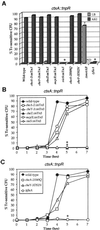Selection for in vivo regulators of bacterial virulence
- PMID: 11391007
- PMCID: PMC34448
- DOI: 10.1073/pnas.111581598
Selection for in vivo regulators of bacterial virulence
Abstract
We devised a noninvasive genetic selection strategy to identify positive regulators of bacterial virulence genes during actual infection of an intact animal host. This strategy combines random mutagenesis with a switch-like reporter of transcription that confers antibiotic resistance in the off state and sensitivity in the on state. Application of this technology to the human intestinal pathogen Vibrio cholerae identified several regulators of cholera toxin and a central virulence gene regulator that are operative during infection. These regulators function in chemotaxis, signaling pathways, transport across the cell envelope, biosynthesis, and adherence. We show that phenotypes that appear genetically independent in cell culture become interrelated in the host milieu.
Figures





References
Publication types
MeSH terms
Substances
Grants and funding
LinkOut - more resources
Full Text Sources

